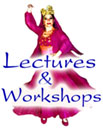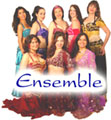- »Classes
- »Workshops/
Special Events - »Calendar
- »Gallery
- »Links
- »About Belly Dance








Habiba
The Studio
Habiba Dance Ensemble
About Belly Dance
Raqs Sharqi: the Oldest Dance
The solo interpretive dance Americans popularly call "belly dance" is actually called raqs al sharqi in the Middle East. It means "Eastern dance." It is one of the oldest documented dance forms and be traced back to ancient Egypt. It has a long history as professional entertainers at weddings and celebrations of all kinds, but it also has a social dance that everyone knows as soon as they are old enough to stand.
In the Middle East, dance and music are inseparable from daily life, a vital part of weddings, feast days, and family gatherings. However, it is only professional dancers that perform for the general public.
It has evolved over the years to be a favorite activity that Middle Eastern women do among themselves at weddings and parties. Traditionally it has been a welcome outlet for women whose opportunities for emotional expression are limited. It has attracted adherents around the globe because it is a perfect vehicle forwomen to express their femininity and their strength.
While the elements of western classic dance include a lot of traveling about the floor and leaping, raqs al sharqi features very little movement about the floor and an earthbound quality. The dancer actually "becomes" the music through movements of the torso, hips and arms.
Template design by Six Shooter Media.
This website and all photographs within, are
©2010 Barbara Siegel, and may not
be used without her permission.
Website maintained by Fatima Bassmah








Habiba
The Studio
Habiba Dance Ensemble
About Belly Dance
Raqs Sharqi: the Oldest Dance
The solo interpretive dance Americans popularly call "belly dance" is actually called raqs al sharqi in the Middle East. It means "Eastern dance." It is one of the oldest documented dance forms and be traced back to ancient Egypt. It has a long history as professional entertainers at weddings and celebrations of all kinds, but it also has a social dance that everyone knows as soon as they are old enough to stand.
In the Middle East, dance and music are inseparable from daily life, a vital part of weddings, feast days, and family gatherings. However, it is only professional dancers that perform for the general public. It has evolved over the years to be a favorite activity that Middle Eastern women do among themselves at weddings and parties. Traditionally it has been a welcome outlet for women whose opportunities for emotional expression are limited. It has attracted adherents around the globe because it is a perfect vehicle forwomen to express their femininity and their strength.
While the elements of western classic dance include a lot of traveling about the floor and leaping, raqs al sharqi features very little movement about the floor and an earthbound quality. The dancer actually "becomes" the music through movements of the torso, hips and arms.
Template design by Six Shooter Media.
This website and all photographs within, are
©2010 Barbara Siegel, and may not
be used without her permission.
Website maintained by Fatima Bassmah
